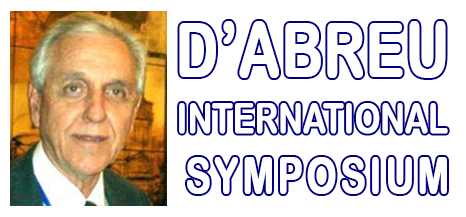List of Accepted Abstracts As of 18/12/2025: (Alphabetical Order)
Summit Plenaries
D'Abreu International Symposium (4th Intl. Symp. on Advanced Sustainable Iron and Steel Making)
Dubois International Symposium (Intl Sympo. on Sustainable Complex Metallic Systems)
Řye International Symposium (Intl Symp. on Sustainable Ionic Liquid and Aluminum Extraction and Processing)
Santilli International Symposium (Intl. Sympo. on Sustainable Mathematics Applications)
Starkey International Symposium (3rd Intl. Symp. on Sustainable Mineral Processing: Principles, Technologies and Industrial Practice)
Yagi International Symposium (2nd Intl. Symp. on Sustainable Metals & Alloys Processing)
Yang International Symposium (3rd Intl. symp. on Multiscale Material Mechanics and Multiphysics and Sustainable Applications)
2nd Intl. Symp. on Advanced Materials and Technologies for
Sustainable Energy and the Environment(AMTSEE)
2nd Intl. Symp. on Multifunctional and Smart Materials, Systems and Structures for Sustainability (MSMSSS)
3rd Intl. Symp. on Sustainable Secondary Battery Manufacturing and Recycling
3rd Intl. Symp. on Sustainable Base-metal Bio-extraction
3rd Intl. Symp. on Sustainable Cement Production
Intl. Symp. World Forum on Sustainable Coal Combustion and Processing
3rd Intl. Symp. on Sustainable Surface and Interface Engineering: Coatings for Extreme Environments
4th Intl. Symp. on Composite, Ceramic and Nano Materials Processing, Characterization and Applications
3rd Intl. Symp. on Sustainable Energy Production: Gas/Oil/Shale; Coal; Nuclear; Waste/Bioprocessing and renewables: wind/waves
5th Intl. Symp. on Environmental, Health, Policy, Legal, Management and Social Issues Related to Metals, Materials and Mineral Processing
3rd Intl. Symp. on Sustainable Production of Ferro-alloys
3rd Intl. Symp. on Sustainable Mining Operations
4th Intl. Symp. on Sustainable Molten Salt and Ionic Liquid Processing
3rd Intl. Symp. on Synthesis and Properties of Nanomaterials for Future Energy Demands
4th Intl. Symp. on Sustainable Non-ferrous Smelting and Hydro/Electrochemical Processing
2nd Intl. Symp. on Physics of Surfaces and Interfaces, from Fundamentals to
Sustainable Applications
4th Intl. Symp. on Quasi-crystals, Metallic Alloys, Composites, Ceramics and Nano Materials
3rd Intl. Symp. on Rare Earth and Platinum Group Metals: Managing and Processing
4th Intl. Symp. on Sustainable Materials Recycling Processes and Products
Intl. Symp. on Rotary Kiln Operations for Sustainable Products
2ND INTL. SYMP. ON MULTIFUNCTIONAL AND SMART MATERIALS, SYSTEMS AND STRUCTURES FOR SUSTAINABILITY (MSMSSS)
Challenges and Results of Nanocomposite and Hybrid Films obtained by Electrodeposition
L.
Benea1 ;
1DUNAREA DE JOS UNIVERSITY OF GALATI, Galati, Romania;
Type of Paper: Regular
Id Paper: 239
Topic: 22Hybrid metal-ceramic or metal-polymer nanocomposite layers containing dispersed second-phase particulates usually have various special properties such as dispersion hardening, self-lubricity, high temperature inertness, good wear and corrosion resistance, or tribocorosion resistance and chemical compatibility. This accounts for the increased application of metal-based hybrid nanocomposite in industry applications and opens also a way to biocompatible films. In order to meet the requirement for developing novel metal-based hybrid nanocomposite, many preparation techniques have been investigated. As a technique conducted at a normal pressure and ambient temperature and of low cost and high deposition rate, electrodeposition is considered to be one of the most important techniques for producing hybrid and nanocomposite coatings with micro or nano structured surfaces. Electrodeposition is exceptionally versatile, so that new and exciting applications are still being invented. The paper presents some challenges and some results regarding the electrodeposition of nano bio ceramic dispersed phases as CeO2,TiO2,TiC, or polymeric dispersed phases as UHMWPE (ultra high molecular weight polyethylene) during cobalt or nickel electroplating processes in view of obtaining bio composite layers or resistant industrial hybrid coating applications.
The micro and nano particles incorporation into the metal matrix by electrodeposition usually causes a noticeable grain refinement and thus an increase in the corrosion and tribocorrosion resistance of hybrid or nanocomposite layers obtained in aqueous or in vitro simulating body fluids (SBF) specific environments. Keywords: Composite; Materials; Nanocomposites; Nanomaterials;
Modern Challenges for Structures Carbon Nanomaterials Characterization
S.
Savilov1 ;
1MOSCOW STATE UNIVERSITY, Moscow, Russian Federation;
Type of Paper: Regular
Id Paper: 338
Topic: 22Different types of carbon nanomaterials, especially carbon nanotubes (CNTs) and graphenes, have been studied carefully during last years bacause of their importance for the majority of actual apllications. Due to a unique set of physicochemical and mechanical characteristics, they are promising objects for the production of diverse composite materials for energy storage and harvesting, polymer industry, adsorption, catalysis.
Synthesis of multi-walled CNTs is technologically most simple, and, depending on the synthesis conditions, products can represent a system of either concentrated embedded cylinder (cy-CNTs) or cones (co-CNTs) from graphene sheets. The surface of cy-CNTs consists of sp2-hybridazed carbon atoms which make it fairly inert, whereas the near-surface layer of co-CNTs contain both sp2- and sp3-hybridized atoms, making them more active in chemical interactions. Graphenes depends on the size, can have a comparable amount of both types of carbon atoms.
Development of new composite materials is impossible without preliminary functionalization of CNTs by carboxyl or hydroxyl groups, which, also, open ways to their subsequent modification with more advanced fragments.
In generally, there is no analytical technique, providing all the information about CNMs. Only a few of them are suitable for mass qualitative analysis of chemically modified CNTs – thermal analysis with IR and mass spectral control of outgoing gases, elemental CHNSO analysis and X-ray photoelectron spectroscopy (XPS). Among these techniques CHNSO and thermal analysis allow to determine the general contents of oxygen in the material, while XPS can be used only to distinguish surface groups. There are also some indirect, but effective, techniques for making similar estimations, such as bomb calorimetry. Present lecture is focused on correlations of the experimental results obtained by different analytical methods of structures carbon nanomaterials analysis and search for the unified set of techniques for their characterization during mass production. Keywords: Composite; Conductivity; Energy; Nanocomposites; Nanomaterials; Porous; Structures; Technology;
Studies of Solid-state Electrolytes for High Energy Storage Devices
L.
Lu1 ;Y.
Zhu1 ;M.
Kotobuki1 ;Y.
Zhang1 ;
1NATIONAL UNIVERSITY OF SINGAPORE, Singapore, Singapore;
Type of Paper: Plenary
Id Paper: 245
Topic: 22Although solid-state electrolytes are old stories, they have recently received intensive attention due to their stability within a wide potential voltage window. In addition to that, solid-state electrolytes are chemically stable in compared with their counterpart, the organic electrolytes. Owing to superior safety and long lives, all-solid-state batteries are regarded as the most advanced materials of the devices for next-generation power storage. One of the crucial components in the all-solid-state battery is solid-state electrolyte materials that require high lithium ion conductivity and good chemical stability against lithium metal and cathode materials have been received great attention in order to fulfil application demand.[1]
One of the potential solid-state electrolytes is the NASICON-structured system including LiTi2(PO4)3, LiZr2(PO4)3 and LiGe2(PO4)3 system. We have studied lithium analogues based on sodium superionic conductor structure, one of the most potential material as a solid electrolyte. Dopants with lower valence such as Al, Ga, In, Ti, Sc, Y, La, Cr are also adopted to substitute A4+ site and therefore enhance the material’s ionic conductivity.[2, 3] However, the application of NASICON material is still restricted by relatively low total ionic conductivity.
To explore a possible solution, we have investigated the synthesis process of lithium aluminum phosphate (LAGP) in this study. Different synthesis methods are used to decrease the porosity of the material as well as increase the uniformity of composition. Detailed parameters were studied to understand their influence on phase transformation progress and to obtain the optimal processing procedure. Systematic characterizations on crystal structure and morphology are conducted for further analysis.
Acknowledgement
This research is supported by National University of Singapore, and the National Research Foundation, Prime Minister’s Office, Singapore under its Competitive Research Programme (CRP Award No. NRF-CRP10-2012-06) and by National Science Foundation of China (NSFC 51572182). Keywords: Energy; Materials;
« Back To Technical Program
|



